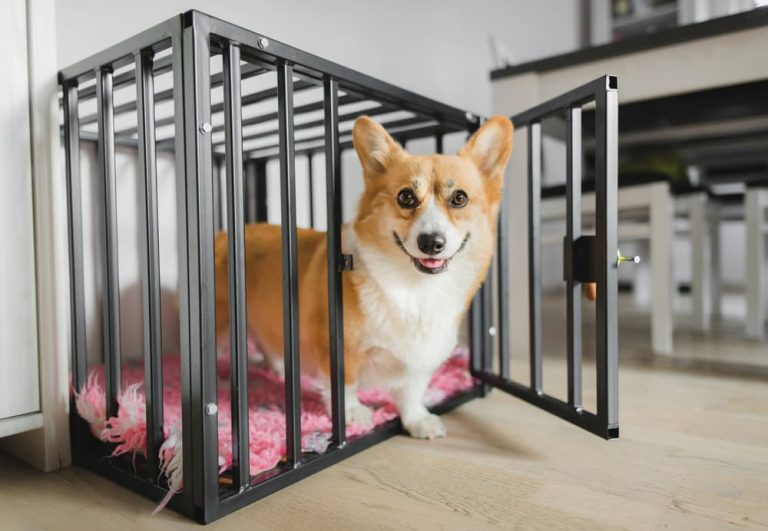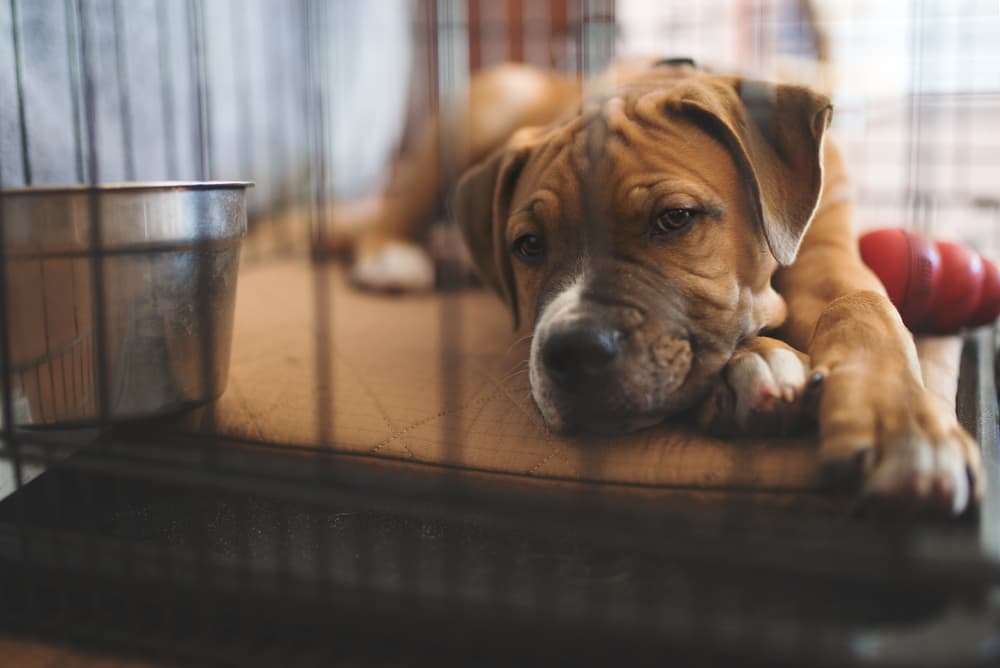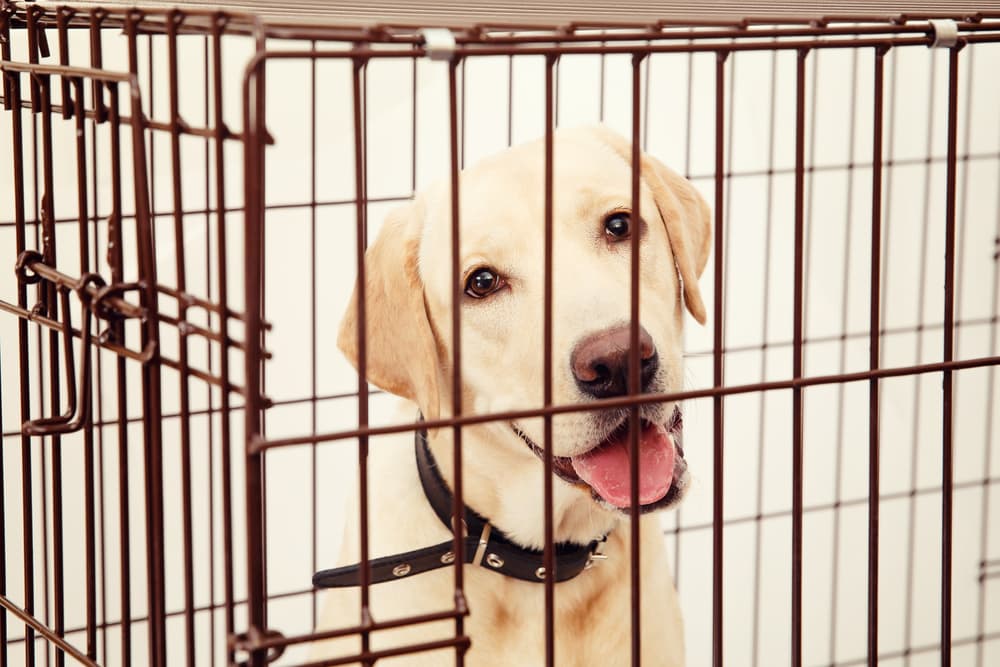Crate Training 101: A Step-by-Step Guide

Ask any pet parent about their number one goal when bringing home a new puppy and the answer is probably speedy potty training. No one wants to spend their first few weeks with their new best friend cleaning puddles and piles from the rug! One of the easiest ways to streamline housetraining is with crate training, a helpful technique that makes the potty process smoother for both ends of the leash. But there’s a lot that goes into figuring out how to crate train a puppy safely, including picking the right type of crate, helping your pup learn to love her new hang spot, and coming up with a puppy crate training schedule. Need some direction? We’re here to help!
What Is Crate Training?

Crate training is a way to tap into your pup’s natural inclination to keep her den clean, which in turn streamlines the potty training process. Most pups won’t potty where they sleep, and with a gradual introduction and positive associations, the crate can become your pup’s go-to nap spot. But using a crate can help with more than just potty training. It’s an easy way to keep your pup from chewing on anything and everything when you can’t watch her, plus it’s helpful when you hit the road and want your pup to have a consistent home base.
How Long Does It Take to Crate Train a Puppy?

Unfortunately, there’s no universal standard as to how quickly your pup will take to her crate. That said, trying to speed through the early introduction steps or forcing your puppy to stay in the crate for too long can derail if not destroy your pup’s association with the crate. When it comes to crate training a puppy, slow, steady, and positive will help ensure your pup is happy inside.
Benefits of Crate Training

Crate training a dog has benefits that go well beyond potty training. A crate can also:
- Keep it safe: Running to the grocery store? Trying to sneak in a quick home workout? The crate can prevent your pup from raiding the garbage can or chewing on cords.
- Keep the peace: In a busy household, it’s helpful to give your pup a break from the hustle and bustle in her crate.
- Keep it familiar: Taking the crate with you when you hit the road will help your pup feel comfortable (and safe) no matter where you are.
- Keep it calm: It’s tough to keep busy dogs low key after surgical procedures, but dogs that are happy in their crates are more likely to chill out inside during convalescence.
- Keep it positive: Adding a new rescue dog to your home, or welcoming in a temporary foster? Crating can help both your resident dog and the newbie acclimate to the change in environment.
Types of Dog Crates

A crate is a crate is a crate? Not quite. There are many dog crates to choose from but only some that are appropriate for crate training a puppy.
- Plastic airplane-style crates: This crate features plastic walls with wire “windows” and is often used for airline travel.
- Wire crates: Wire crates are exactly what they sound like; sturdy containment systems made of metal.
- Furniture-style crates: The focus is on fashion with this type of crate, which is usually made of wood to blend in with home décor.
- Mesh crates: These soft-sided nylon crates are easy to transport and set up quickly.
While there are many different types of crates available and design options within each style (like multiple access points and removable sizing panels), your choices narrow if you’re crate training a puppy. Some crate types, like wood furniture style or mesh, aren’t suitable for puppies because they can become targets for chewing. Instead, look for sturdy crates constructed from puppy-safe materials. Style is a bonus, but should not come at the expense of safety and function.
Finally, when picking a crate for your puppy, make sure it’s the proper size. Your puppy should be able to stand up, turn around, and lie down comfortably inside without too much extra space. Putting your pup in an oversized crate might allow her to potty in one corner and sleep in the other, so if you need a crate that will eventually accommodate a larger breed dog, invest in the largest size you’ll need and use a space-reducing insert that can be moved as your pup grows.
Crate Training 101: A Step-by-Step Guide

During the initial steps of crate training, it’s important to let your puppy set the pace. Pushing your dog to go inside it if she’s reluctant might slow the process, or worse, make your puppy afraid of the crate. The following steps are a template for introducing the crate, but keep in mind that pups are individuals and progress at their own pace. Some will race through the process while others might take a little longer before they feel comfortable.
Step 1
Place the crate in a central location, leave the door open, and let your puppy explore it.
Step 2
Praise your puppy for checking it out and toss small, savory treats just inside of it. Make a fuss if she chooses to walk in, but don’t force her to if she seems reluctant. You can praise any interest in the crate, even glances at it.
Step 3
As your puppy gets more confident about going into the crate, place treats toward the back of it so she has to go all the way in to get them. If your puppy walks in and stays inside, praise her and give her a few special treats while she’s in it.
Step 4
Feed your puppy her meals in her crate during the introductory process. If your puppy doesn’t want to go all the way in, place the bowls just outside of the crate, then gradually move them in with each meal.
Step 5
When your puppy is happily going into the crate, try closing the door for a few seconds. Stay nearby for a few quick trials, then let her go in, close the door and move farther away while your pup is inside. Alternate the length of time your pup is inside as well as how far you move away from it, meaning: During some brief sessions, put your pup in the crate, close the door, and leave the room for a few seconds. In other sessions, put your pup in, stay close by, but wait a slightly longer time.
Step 6
Repeat these brief closed-door training sessions over the course of a few days.
Step 7
Once your puppy seems calm and happy being in the crate, give her a treat-stuffed busy toy and extend the amount of time she’s in the crate. You can alternate being in or out of the room.
Step 8
When your dog is well-adjusted to being in the crate, try leaving the house for a brief period. When you return, let your puppy out, greet her calmly, and take her outside for a potty break.
Other Crate Training Tips

Here are a few more pieces of advice to set you and your pup up for crate training success:
- Play with your dog prior to longer crate sessions so she’ll be more likely to fall asleep while inside, but make sure to give her a potty trip before putting her in.
- Take off your pup’s collar or harness while she’s inside.
- Give your puppy a treat-stuffed busy toy when you put her in the crate, but avoid leaving “untested” toys when your pup is unsupervised, as they could be a choking risk.
- Don’t leave your puppy in the crate for longer than she’s physically capable of holding it, as it could force her to soil it. (Plus, over-crating is cruel.) You can compute your pup’s rough “hold time” by taking her age in months and converting it to hours. For example, a 12-week-old dog can hold it for roughly three hours.
- Give your puppy a potty break before putting her in the crate and immediately after letting her out of it.
- When considering how to crate train a puppy at night, remember that very young pups probably can’t hold it for the entire night. Keep the crate either in your bedroom or nearby so you can hear her if she wakes up and needs to go outside.









